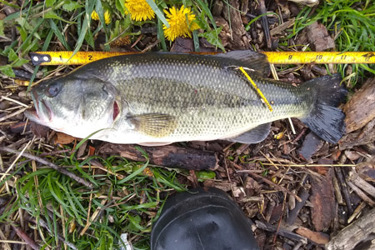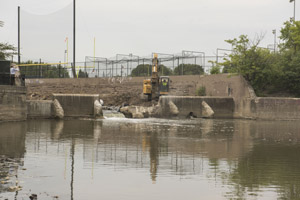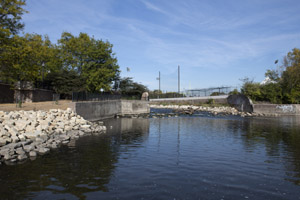A True Fish Tale: Chicago Project Removes Dam, Reclaims Waterway
By Allison Fore

When a largemouth bass tagged by the Metropolitan Water Reclamation District of Greater Chicago reappeared 30 miles away, it was not just evidence of migration — it was proof of concept for ecological restoration.
A largemouth bass recently caught in the Skokie River is giving new optimism and understanding for fish migration in the Chicago Area Waterway System (CAWS) for scientists with the Metropolitan Water Reclamation District of Greater Chicago (MWRD) and partners.
MWRD aquatic biologists originally caught the fish in October 2019, in the North Branch Canal by Goose Island during a routine fish survey. Less than seven months later, fisherman Sey Jay was fishing in the Skokie River just south of the Skokie Lagoons by the Erickson Woods in the Cook County Forest Preserves near Winnetka when he came across the same fish. Another fisherman had left their catch behind on a stringer that was snagged on a log, he said.
“I was going to toss it back and noticed it had a tag on its back,” said Jay, who has been fishing local spots for about 40 years and markets frozen fish for a living. He decided to look a little closer and noticed tag number “34111” with the MWRD’s name on it.
An Important Catch
This rare find would never have been possible if not for a partnership effort to remove a century-old dam on the North Branch of the Chicago River in 2018. Located at the confluence of the North Branch and North Shore Channel between Foster Avenue and Argyle Street, the dam was demolished as part of a restoration effort by the U.S. Army Corps of Engineers, Chicago District (USACE), MWRD, and Chicago Park District to allow upstream fish migration and improve recreational opportunities.
“We study fish in our continuing assessment of water quality, and this incredible discovery suggests remarkable fish mobility and a healthy ecology that has been made possible by our many partnerships interested in river restoration,” said MWRD President Kari K. Steele. “We thank our fisherman for relaying this big catch and our many stakeholders determined to provide thriving ecosystems in our waterways.”
This was an important catch and more proof that dam removals provide fish passage and the potential to promote biodiversity in the Chicago area waterways, according to Margaret Frisbie, executive director of Friends of the Chicago River.


The demolition of the North Branch Dam has led to a wide opening for the passage of fish to swim upstream.
“Friends of the Chicago River has been imagining fish swimming freely through the river since 2002 when we started the dam removal project with Illinois Department of Natural Resources (IDNR) almost two decades ago," said Frisbie. "This largemouth bass represents strong partnership between the Chicago Park District, IDNR, Metropolitan Water Reclamation District, the U.S. Army Corps, and Friends [of the Chicago River], as well as good stewardship, tenacity, and proof that if we invest in the Chicago River system, wildlife will respond. We could not be more thrilled.”
The North Branch Dam and its four-foot drop have now been replaced by a series of riffles, step pools, cobbles, gravels, and sands that slow the flow of water and make it possible for the fish to pass upstream. During a feasibility study, USACE biologists sampled the reach just upstream of the dam and only found one green sunfish. Now fish are abundant.
“It’s fantastic to see that fish are responding to the removal of the dam, but it’s also not surprising,” said Nicholas A. Barkowski, fish biologist at the USACE. “Fish were observed by USACE staff swimming upstream during the demolition. As soon as a large enough gap was created in the dam, fish started making their way upstream.”
USACE fish biologists also conducted a 15-minute electro-fishing survey downstream of the dam in 2019. A total of 266 fish were captured and 17 native species were identified utilizing the confluence of the North Branch of the Chicago River. Bluegill, gizzard shad, and largemouth bass were the three most abundant species. Other notable recreationally important species consisted of white crappie, channel catfish, and pumpkinseed. USACE plans to conduct additional monitoring upstream of the confluence in the summer of 2020 to further monitor the success of the dam removal.

A largemouth bass traveled upstream on the North Branch of the Chicago River and crossed into the Skokie River approximately 30 miles away. (Map provided by Austin Happel, Shedd Aquarium.)
Wild (Mile) Journey
The fish, estimated to be four to five years old, was one of 10 largemouth bass that were tagged by the MWRD in 2019 in support of the Wild Mile Chicago project, coordinated by Urban Rivers. None of the other fish were reportedly recaptured. On the Wild Mile, along the North Branch Canal and Turning Basin between Chicago and North Avenues, Urban Rivers and the Shedd Aquarium are creating the world’s first mile-long floating eco-park. The project reclaims the waterway while providing an accessible public space for the community. The Wild Mile was outlined over the course of many community meetings with the Chicago Department of Planning and Development to build a renewed urban ecology. Partners and planners said it will help generate cleaner, healthier water and more vibrant wildlife ecosystems.
As part of the project, several improvements will be made to River Park, located at Foster Ave., including the restoration of 29 acres of savannah habitat, 14 acres of riverbank, and five acres of aquatic beds by removing invasive species and establishing native bank vegetation.
With a diverse ecosystem of natural vegetation and an established riparian savannah on banks and parkland natural areas, River Park will welcome boaters, an abundance of fish and aquatic wildlife, and birds and other species relying on a reborn Chicago River as a food source. Recognizing the importance of designating property along the waterways for public recreational uses or green space that aids in water quality improvements and stormwater management, the MWRD leases the 30-acre River Park area to the Chicago Park District for a nominal fee.
MWRD aquatic biologists collect and monitor aquatic life through fish surveys. The MWRD conducts fish monitoring periodically at 28 locations throughout its service area, which includes the Chicago, Calumet, and Des Plaines River Systems. They weigh, measure, and inspect fish for disease and other anomalies before releasing the fish back, unharmed, into the water.
“Since the MWRD began monitoring in 1974, our scientists have seen the number of fish species found in the CAWS rise from 10 to 77, including 60 that have been found in the CAWS since 2000,” said Commissioner Mariyana Spyropoulos. “Our work to improve processes has had the projected impact of dramatically improving the area waterways, and the future of the CAWS is bright.”
 Allison Fore has served as the Public & Intergovernmental Affairs Officer at the MWRD since 2011. She has more than 25 years’ experience in government communications, having also worked for the Illinois State Treasurer, Illinois General Assembly, Indiana Secretary of State, and Indiana Department of Environmental Management. She received her Bachelor of Science in Public Health degree from Indiana University’s School of Public and Environmental Affairs and Master of Arts degree from the University of Chicago’s School of Social Service Administration.
Allison Fore has served as the Public & Intergovernmental Affairs Officer at the MWRD since 2011. She has more than 25 years’ experience in government communications, having also worked for the Illinois State Treasurer, Illinois General Assembly, Indiana Secretary of State, and Indiana Department of Environmental Management. She received her Bachelor of Science in Public Health degree from Indiana University’s School of Public and Environmental Affairs and Master of Arts degree from the University of Chicago’s School of Social Service Administration.

